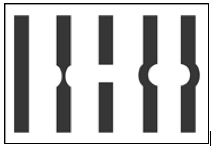Macular hole
A macula hole is a defect that develops at the central fixation point of the eye (macula). It is most often seen in older individuals, but may also be seen in highly short-sighted eyes or eyes with severe injury.

A macular hole confirmed on a scan. The hole should be repaired early
to improve the surgical success rate.
Symptoms
 Central vision becomes blurred or distorted and everyday tasks like reading, recognizing faces, driving or household chores become difficult or impossible.
Central vision becomes blurred or distorted and everyday tasks like reading, recognizing faces, driving or household chores become difficult or impossible.
A useful eye test is to use the “Amsler chart” which helps check central vision in macular diseases. Otherwise, you can test your eye’s central vision by looking at straight lines around your environment (like the edge of a door or window or painted lines on the roads, etc).
In macular hole eyes, straight lines may look distorted or may have a missing middle portion.
If you have any unusual visual distortion using the Amsler chart or while looking at straight lines, you should see your eye doctor as soon as possible.
Treatment
The most effective treatment currently is surgery (Vitrectomy). The success of surgery depends on many factors, and one of the most important is duration of the hole. The longer the hole has been left untreated, the less likely the hole will close after surgery. To maximize success, it is advisable to undergo surgery for macular hole within 6 months of having symptoms.
An alternative to vitrectomy surgery is injection of the drug “Ocriplasmin” into the eye. However, this treatment is only suitable for certain individuals, and success rates are not as high as with vitrectomy surgery.
FAQs about macular holes
For individuals with a macular hole in 1 eye, is the other eye at risk as well?
Studies have shown that for individuals with a macular hole in 1 eye, the other eye is at significant risk of also developing a macular hole.
This is the reason why a macular hole should be repaired early to increase the success rate and secure vision in 1 eye in case the other also develops a macular hole. The “good eye” of an individual with a macular hole should be monitored regularly to pick up a macular hole early.
Will vitamin or dietary supplements help in the treatment of macular holes?
Vitamin or dietary supplements are not known to help in the treatment of macular holes. The only effective treatments are vitrectomy surgery and (to a lesser extent) Ocriplasmin eye injection.
